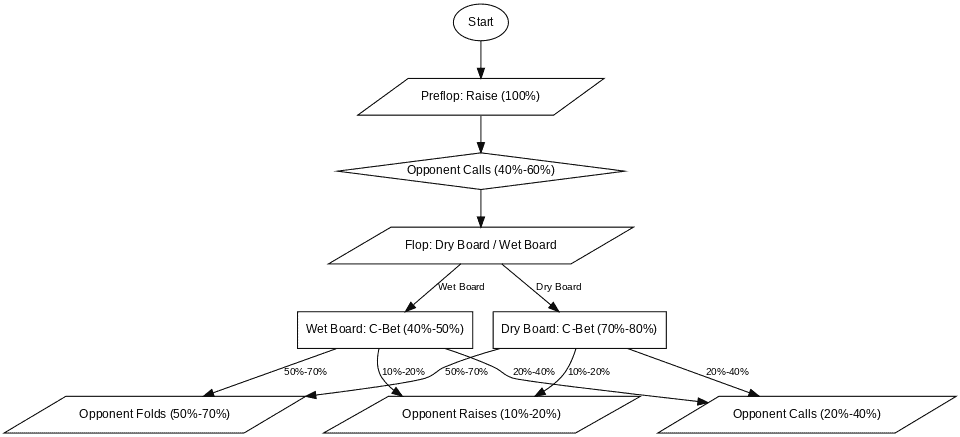
C-Betting in Poker: When, Why & How to Use It Effectively
In poker, your move will have an impact on your long-term success. One of the best moves played consistently by experienced players is the continuation bet (c-bet). It is a bet placed on the flop following a preflop raise, no matter whether your hand strengthened. Timing a perfectly timed c-bet can build your pot, make opponents fold, and make them unsure about your move.
But in what manner can your move work for you and not make your move predictable? Let’s break it down.
How Come C-Bets Succeed?
A c-bet works because of a simple fact: most hands miss the board. In Texas Hold’em, a player will make the board about 35% of the time. That leaves 65% of hands that have missed, and will therefore fold most times.
Also, having displayed preflop strength with a raise, your opponents will fold out hands with less strength, assuming that you have a strong one. With your move, you can win little pots consistently, and over a session, that can make a big impact.

What Makes a Successful C-Bet?
Not all circumstances lend themselves for a successful c-bet. There are specific factors that will make your bet profitable:
1. Opponent Count
- Optimum for Heads-Up Pots: Fewer opponents in your pot, the better a c-bet will work. With one opponent, there’s a larger chance that they have missed the board.
- Riskier in Multiway Pots: With many opponents, the odds increase that at least one of them will have hit the board. In such a case, your c-bet will have to become selective.
2. Board Texture
- Dry, Uncoordinated Boards: Boards like K-7-2 rainbow (no draw flops) are ideal for c-betting. Opponents have less opportunity for having hit such boards.
- Wet, Draw-Rich Boards: Boards such as 9-10-J with two spades are dangerous in that they have many draw and straight options. C-betting on such boards is not a good move, except when having a strong holding.
3. Your Table Image
Consistent c-betting of all your hands will have sharp opponents becoming wise and counterattacking you. Varying your move sometimes keeps them in the dark.
How Much to C-Bet?
The bet sizing comes in when deciding whether your c-bet will work.
- Bet little, and opponents will call too frequently.
- Bet high, and chip out unnecessarily.
General C-Bet Rules
- Half the Pot (50%): Best for dry boards when opponents will fold.
- Two-Thirds of the Pot (66%): Typical sizing putting enough pressure but keeping your bluffs in range.
- Three-Quarters of the Pot (75%): Employed in wet boards to rob draw hands of equity.
Adapting to Opponents
- Against Tight Players: C-bet with a little bet, as a poor holding will fold against a tight opponent.
- Against Loose Players: C-bet big, as a big bet will discourage them from chasing a draw with a poor holding.
Master C-Betting Techniques

Once your fundamentals have become part of your skillset, use these expert techniques to level up your game.
1. The Delayed C-Bet
A delayed c-bet is when, instead of betting on the flop, you check but then bet on the turn. It can work incredibly effectively, particularly with opponents who prefer floating the flop (calling with a steal in mind for a future street).
Example: You bet preflop with AQ, and the board comes out K-7-2. Instead of firing an immediate c-bet, you check. If your opponent checks back, bet on the turn when the board is safe.
2. Double Barrel (Turn C-Bet)
Once your opponent calls your flop c-bet, a double barrel, firing a bet for a second time, is an alternative for you. It works best when:
- The turn card strengthens your range (e.g., an Ace or King comes in).
- Your opponent will fold to amplified aggression.
- The board isn’t yet in your opponent’s range.
3. Triple Barrel (River C-Bet)
And then comes the most extreme one—bet three times, all three streets. It’s a high-variance, high-payoff move that works best when your strong hand narrative is uniform and persistent. If your opponent reaches the river with a draw, a proper triple barrel can make them fold.
Mistakes in C-Betting That Everyone Makes
Experienced players make mistakes with c-bets, too. What follows are common ones and tips to avert them:
1. C-Betting Too Often
The minute you bet every single flop, your opponents will start raising and even calling more often. To maintain your unpredictability, mix in a little checking even with strong hands.
2. Not Accounting for Opponent Tendencies
Some opponents fold zero times to a c-bet. If your opponent is one such player, your bluffs become a chip waster. Instead, value bet with strong hands.
3. Misinterpreting Board Texture
A c-bet on a board with little draw value (e.g., K-4-2) works perfectly, but attempting a bluff on a coordinated board (e.g., 8-9-10 with two spades) is a gamble. Intelligent opponents will see through it and raise or even call.
C-Betting in Varying Situations
Now, let’s see how to implement your c-bet strategy in different poker structures.
Cash Games
- The deep stacks will work in your favor with c-betting.
- A lot of room for maneuver will be present with barrels.
- The opponents will have a balanced range.
Tournaments
- The stacks will become shallow, making your c-bets riskier and less inviting.
- Opponents will have a high probability of calling due to ICM (Independent Chip Model) considerations.
- The bets will have to become smaller in size to preserve your stack.
The Role of Poker AI in C-Betting Strategies
Now that poker AI and poker bots have become a reality, complex strategies have become more common. Software programs such as Pluribus poker AI and DeepStack AI analyze millions of hands to determine optimal c-betting frequencies. These tools won’t play for you, but they can enhance your decision-making.
Also, poker cheat sheets provide best-fit c-bet frequencies for board textures and opponent types. With such tools, diligent grinders can sharpen their edge.
Final Thoughts: How to Get the C-Bet to Do its Thing

The continuation bet is one of poker’s most powerful tools in your arsenal. With it, unchallenged, you can win, apply pressure, and have a say in pot direction. As with any technique, it will work best when played selectively and in specific scenarios.
By factoring in board textures, opponent types, and bet sizing, mastering the c-bet will become second nature, and your poker wins will boom. Next time you raise preflop, remember to follow through with a follow-up bet post-flop—because a successful c-bet can make a big impact.
